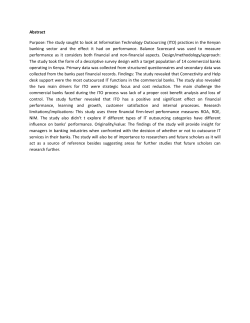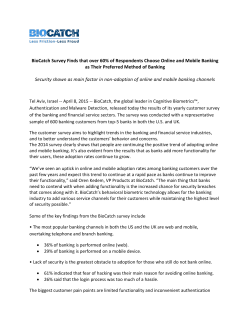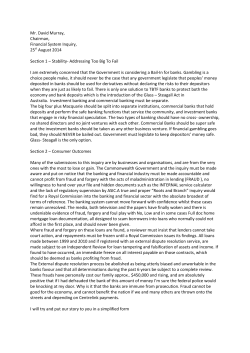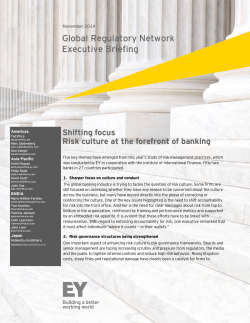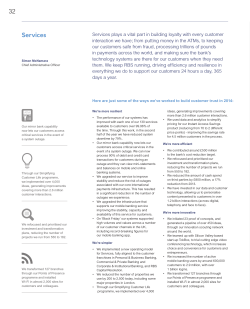
Capital Markets Union: What needs to be done?
European Banking Federation – Speech – Check Against Delivery Capital Markets Union: What needs to be done? 18 March 2015 Wim Mijs, President of the European Banking Federation Institute of Law and Finance, Goethe University, Frankfurt Good afternoon ladies and gentlemen, It’s a great pleasure to be here. Before we concretely discuss the views in the banking sector on the plans for a Capital Markets Union, please let us make sure that we do not lose sight of the bigger picture. The ultimate objective of CMU is to generate economic growth, to help companies create jobs. What we are really talking about here is the European economy. We should ask ourselves for a moment if we really are on the right track. Are we? The nature of the European economy is such that banks are a crucial and important factor. Even when more alternative sources of funding become available and when markets will play a bigger role that will not change. Approximately two-thirds or three-quarters of all funding needs in Europe continues to be based on a strong preference for bank funding. Our part of the world has a strong historic and cultural preference for going to the bank instead of the market. Bank funding often is less complex than having to go to markets – and therefore also cheaper. That’s very different from the United States, where the economy depends largely on financial markets for funding. It’s important that we do not ignore these cultural differences. Capital Markets Union may have been inspired by the fact that the bank transmission system in Europe in recent years has not managed to delivery fully what was expected. We take great comfort in 1 comments that Commissioner Jonathan Hill made last month, when he said Capital Markets Union is not about displacing banks, but about complementing the role of banks. 1 http://europa.eu/rapid/press-release_SPEECH-15-4494_en.htm European Banking Federation aisbl – 56 Avenue des Arts, B-1000 Brussels Phone: +32 2 508 37 11 – Website: www.ebf-fbe.eu Page 1 of 5 Let us take a look at some of the factors that play a role when it comes to financing the European economy: This cartoon tries to illustrate some of these points. Imagine the European economy as a pool, a pond full of fish. Fish, gasping for water. Big ones… small ones… and dead ones as well. On the horizon… the ECB making available vast quantities of funds, at a rate of €60 billion per month. The cartoonist has pictured the European banking system as the transmission system for these funds… the water… to make it to the pool. The system, the transmission pipeline, is being squeezed… To name just a few of the measures that the banking sector has to deal with… enhanced supervision… more and better capital and liquidity… such as CRR… bail-in and resolution financing arrangements like BRRD… It may have made the pipeline safer, but at the same time it also is squeezing the flow. Banks are facing even more tough measures… Global loss-absorbing capital measures such as TLAC are due to be adopted later this year… Eleven EU member states, supported by the European Commission, are pushing ahead with plans for a financial transaction tax. And on top of all that there’s this little pirate… with the plans for structural reform for the banking sector… trying to split up the biggest banks because he believes that all these new rules have not yet dealt properly with too-big-too-fail. It is not difficult to imagine that such a changing environment with new and heavy regulation makes banks cautious when it comes to make funds available. But let me take this moment to emphasize that I am an optimist. Page 2 of 5 It’s not like banks are squeezed to death. The new regulations and Banking Union indeed made the banking sector safer. It’s highly unlikely that tax-payers will be called upon to rescue a bank in the event of a new bank failure. Bond holders and investors now are first in line. So let’s turn to Capital Markets Union. Capital Markets Union is important as a project that can help address fragmentation in Europe’s financial services markets and that can encourage renewed integration. Our sector strongly feels financial integration is tremendously important for the EU economy. The European Banking Federation, ever since it was created in 1960, works hard to contribute to that integration. However, reality requires all of us to admit that despite all the efforts of the European Union, the 2 financial services markets in Europe remain deeply fragmented. A report that we published last October even shows that fragmentation in Europe’s financial markets has even increased again during the years that followed the financial crisis. Just to given one example: the share of cross-border debt securities in the euro area was only 16% in 2013, compared to 30% at the beginning of 2008. One of the good things about Capital Markets Union is that it provides a clear and fresh focus on removing obstacles, on removing barriers to growth. We also very much welcome the focus of the new European Commission on growth and jobs, and on better regulation. Turning Capital Markets Union into a success also requires us to acknowledge and define some of the factors that could prevent it from delivering on its potential. Regulatory uncertainty is one of them. The Green paper makes clear that CMU has a broad scope, with the prospect of various different measures for the short, medium and long term horizons. That means we can expect many different measures. The drawback of this broad scope also is that it creates uncertainty. 2 http://www.zyyne.com/zh5/140638#p=1&z=1 Page 3 of 5 The financial services industry – banks as well as investors and markets - need certainty on the limits of regulation. After the avalanche of new rules that have been introduced in recent years, it is becoming difficult for our industry to keep up with the continuous flow of new regulations. We see another risk in one of the key success factors for Capital Market Union: the willingness of national governments to embrace change. If fragmentation is to be addressed properly, national securities laws need to be harmonized. But how will it for example be possible to reconcile home repossession laws in Italy with those in Sweden. In Italy it can take five years, while in Sweden a home can repossessed in merely six months. Differences such as these will not make it easy to securitize mortgages at a European level. This also raises the question: Is CMU too long-term to be viable? So what needs to be done to make Capital Markets Union work? First, we need to ensure market liquidity. If there is no liquidity, there will be no market. All stakeholders need to acknowledge that it is not possible to regulate a market into being. A market needs liquidity… ample supply and demand. We need to make sure that any new regulation will not harm existing, functioning markets. Banks are key liquidity providers for the European markets. CMU needs to protect the liquidity we already have and at the same time encourage even more…. People who invest in these markets need to be made to feel confident so that they can buy and sell what they need, when they need to do so. In this context, we also welcome the review of the prospectus directive. Secondly, it’s important that CMU guarantees a level playing field. Page 4 of 5 You cannot regulate banks and then let other market participants operate conduct similar activities under different rules. Equal terms are required for all those who put money into the economy, both form the EU and outside the EU. Also for financial markets in Europe, equal terms are needed, applying to actors from the EU as well as from other parts of the world. And thirdly, we see a necessity for a regulatory pause. We need to make sure that we correctly implement the existing regulatory framework, with Mifid, Mifir, the Single Rule Book, BRRD. These new regulations should not be allowed to complicate CMU. While we are doing this, we should stop talking about plans for a Financial Transaction Tax. And Banking Structural Reform should not be introduced without carefully considering the unintended consequences. Capital Markets Union must unlock the latent potential of EU financial markets to support bank funding in the economy. It needs to result in innovative, market-based initiatives that enables financial markets contribute to growth, and that instils companies with the confidence they require to invest and create more jobs. The success of the CMU project will also depend on how the EU handles the proposal to break up banks and the financial transaction tax. IF we are not careful, these plans will harm liquidity and weigh down capital markets. This risks a scenario where the EU goes full throttle - with the hand brake on. As banking sector we fully support growth and jobs initiatives. We are keen to see concrete measures such as the plans to revive securitisation markets. We welcome the CMU as a project that centres on free circulation of capital in the EU and appreciate the renewed focus on integration in our financial services markets. Thank you for your attention. Page 5 of 5
© Copyright 2025



